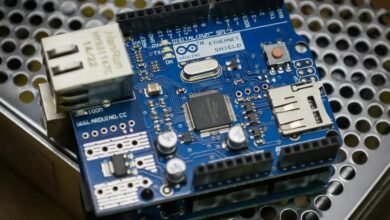Biological engineering: making progress through technology
Biological engineering or bioengineering which includes biological systems engineering is a discipline that applies physical and mathematical concepts and methods to solve problems in the life sciences, using analytical and synthetic engineering methodologies.
The difference between biological engineering and biomedical engineering can be unclear, as many universities use the terms bioengineering and biomedical engineering with the same meaning.
In this context, while traditional engineering uses the physical and mathematical sciences to analyze, design, and manufacture nonliving tools, structures, and processes, bioengineering uses the same sciences to study many aspects of living organisms.
Benefits and uses of biological engineering
It is generally used to analyze and solve problems related to human and animal health and biological systems useful in food and drug production. It is the branch of engineering that deals with the technological application of biological systems, living organisms, or their derivatives to create or modify products or processes for a specific use. To do this, biotechnological engineering makes use of natural sciences such as chemistry, physics, mathematics, and other specialized disciplines resulting from the combination of these, for example, biochemistry, bioengineering, and biotechnology.
In many countries, it is a career in biotechnology, while in Colombia, Uruguay, Chile, and more recently Mexico it is presented as a professional career in itself.
The applications are specifically related to human health, but the field may be more general. For example, biomimicry -or biomimetics- is a branch of biological engineering that attempts to understand how living organisms, as a result of a long process of trial and error known as evolution, have solved difficulties in the past, and to find ways to solve them. . they. Similar problems in artificial systems.
On the other hand, systems biology seeks to use reverse engineering concepts to facilitate challenging learning processes about the structure, function, and precise ways of operating complex biological systems.
Biological engineering is a scientific discipline that is based on the biological sciences in the same way that chemical engineering, electrical engineering, and mechanical engineering are based on chemistry, electricity, magnetism, and classical mechanics, respectively.
Biological engineering can be distinguished from pure biology or classical engineering in the following way: Biological studies often follow abbreviated approaches, presenting a system at the smallest scale possible, leading to tools such as functional genomics.
Engineering approaches use classical design perspectives in a constructivist way, developing new devices and technologies. Biological engineering uses both methods, using shorthand to identify, understand, and organize the basic units of biological matter, which are combined to generate something new. Scientific knowledge in solving real and everyday problems.
Although bioengineered systems are used to manage information, building materials, chemical processes, energy production, food production, maintain human health, and restore the environment, they are still less developed than electrical or mechanical systems.
However, according to Professor Doug Laufenberg of MIT, biological engineering has a broad base in which it applies engineering principles to a huge range of systems of different complexities and sizes, from the molecular level to macroscopic levels such as an ecosystem.
Neither biological engineering nor biomedical engineering is completely contained in each other, just as there are non-biological products in medicine, there are biological products for non-medical purposes.
ABET, the accreditor of engineering programs in the United States, makes a distinction between biomedical engineering and biological engineering, but the differences are very small.
Biomedical engineers must take life science courses that include human physiology and must have experience measuring parameters of living things; while biological engineers must have science courses and experience in parameter measurement in living and non-living systems; They usually include common engineering courses such as thermodynamics, fluid mechanics, statics, and properties of materials.
The word bioengineering was coined by the English scientist and broadcaster Heinz Wolff, in 1954.
It is also used to describe the use of vegetation in civil construction engineering. It can also be applied to environmental modifications such as the protection of the soil surface, the stabilization of slopes, the watercourse, the protection of coasts, windbreaks, vegetation barriers, acoustic barriers, and visual screens, and the ecological improvement of an area.
The first academic program in biological engineering was created at the University of Mississippi in 1967 and was the first biological engineering curriculum in the United States. Other recent programs have been launched at MIT and the University of Utah.
Biological engineers or bioengineers are engineers who use the principles of biology and engineering tools to create useful, tangible, and economically viable products. Biological engineering draws on the knowledge and experience of several pure and applied sciences, such as mass and heat transfer, chemical kinetics, biocatalysts, biomechanics, bioinformatics, process separation, and purification, bioreactor design, surface science, fluid mechanism, thermodynamics, and polymer science.
It is used in the design of medical devices, diagnostic equipment, biocompatible materials, renewable bioenergy, ecological engineering, and other areas that improve the quality of life of societies.
In general, biological engineers attempt to mimic biological systems to create products or to modify and control biological systems so that they can replace, augment, or sustain chemical and mechanical processes.
Bioengineers can apply their experiences to other engineering and technology applications, including genetic modification of plants and microorganisms, bioprocess engineering, and biocatalysis.
Because other engineering disciplines also deal with living organisms eg prosthetics in mechanical engineering, the term biological engineering can be broader to include agricultural engineering and biotechnology. Many old departments of agricultural engineering in universities around the world have changed their names to biological or agricultural engineering and biosystem engineering.
Biological engineering is also known as bioengineering in some colleges and others, biomedical engineering is known as bioengineering, and it is a rapidly developing field with the categorization of liquids.
Biological engineering and bioprocess engineering
Bioprocess design, biocatalysis, bioseparation, bioinformatics, bioenergy: a biotechnology or chemical engineering specialization.
It is concerned with the design and development of equipment and processes for the manufacture of products such as food, feed, pharmaceuticals, nutraceuticals, chemicals, polymers, and paper from biological materials.
Bioprocess engineering is a conglomeration of mathematics, biology, and industrial design, and is made up of various spectrums such as the design of fermenters, the study of fermenters’ mode of operations, etc.
It is also concerned with studying the various biotechnological processes used in large-scale production industries of biological diversity, products for the optimization of the yield in the final product, and the quality of the final product.
Genetic engineering
It’s synthetic biology, horizontal gene transfer. Also called genetic modification; is the direct human manipulation of an organism’s genome using modern DNA technology. It involves the introduction of foreign DNA or synthetic genes into the organism of interest.
The introduction of new DNA does not require the use of classical genetics methods, however, traditional breeding methods are normally used for the propagation of recombinant organisms.
Biomedical engineering
Biomedical technology, which includes biomedical diagnostics, biomedical therapy, biomechanics, and biomaterials, is the application of engineering design principles and concepts to medicine and biology.
This field seeks to bridge the gap between engineering and medicine. It combines design and engineering problem-solving with medical and life sciences to improve health in diagnosis, monitoring, and treatment.
Biomedical engineering has recently emerged as its discipline, compared to many other engineering fields.
Such evolution is common as a new field transitions from being an interdisciplinary specialization between fields that are already established, to being considered a field in its own right.
Much of the work in biomedical engineering involves research and development, covering a wide range of subfields.
Prominent biomedical engineering applications include the development of biocompatible prostheses, various diagnostic and therapeutic medical devices ranging from clinical equipment to micro-implants, and common imaging equipment such as magnetic resonance imaging and electroencephalography, tissue growth regenerative, drugs, and therapeutic biological products.
In conclusion
We find that biological engineering represents an exciting and diverse field that combines engineering and life sciences to create innovative and cutting-edge solutions to many of the health and environmental challenges we face today. Through rapid progress in this field, we see significant improvement in areas such as medicine, agriculture, and the environment.
Biological engineering seeks to use engineering concepts and techniques to understand and analyze biological systems, and then develop effective solutions to global health and environmental challenges. Through the combined efforts of bioengineers and bioscientists, we see the potential to improve quality of life and provide innovative solutions to problems related to health and the environment.
As a diverse and evolving field, biological engineering opens new horizons for innovation and development in various fields. As technology continues to evolve, we expect bioengineering to continue to play a role in improving the quality of life and solving our health and environmental problems in more effective and sustainable ways in the future.





